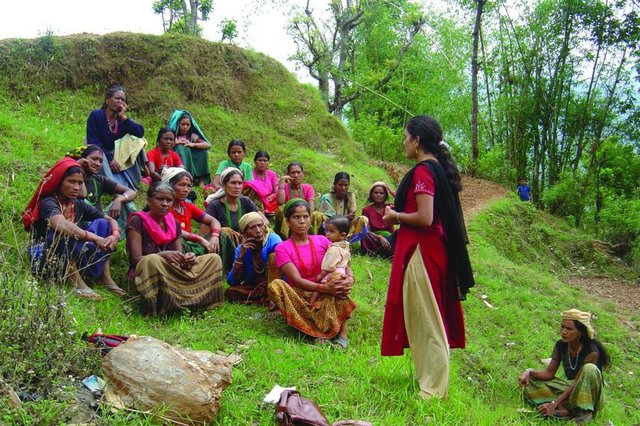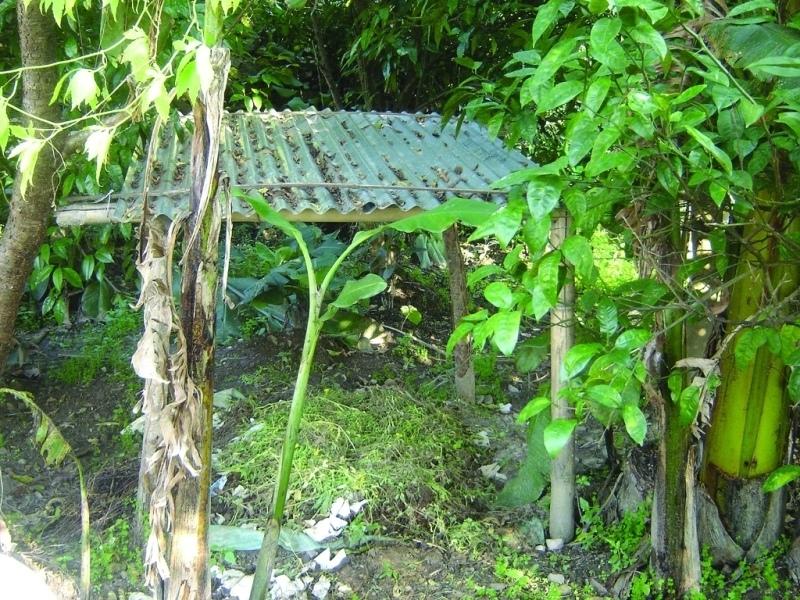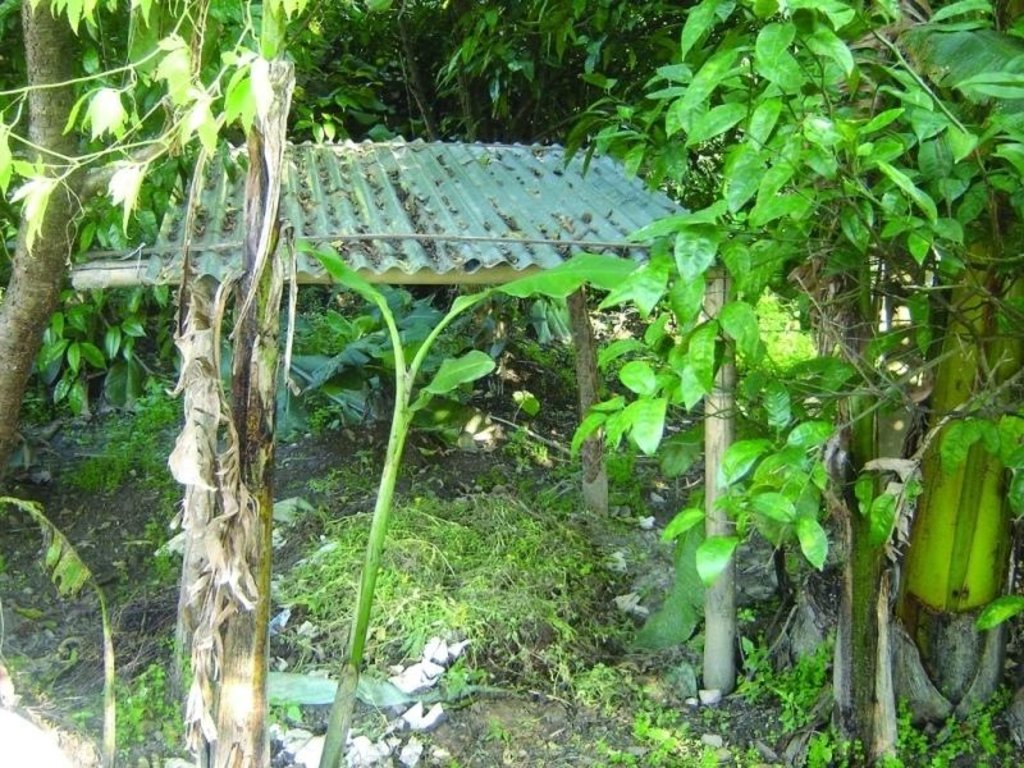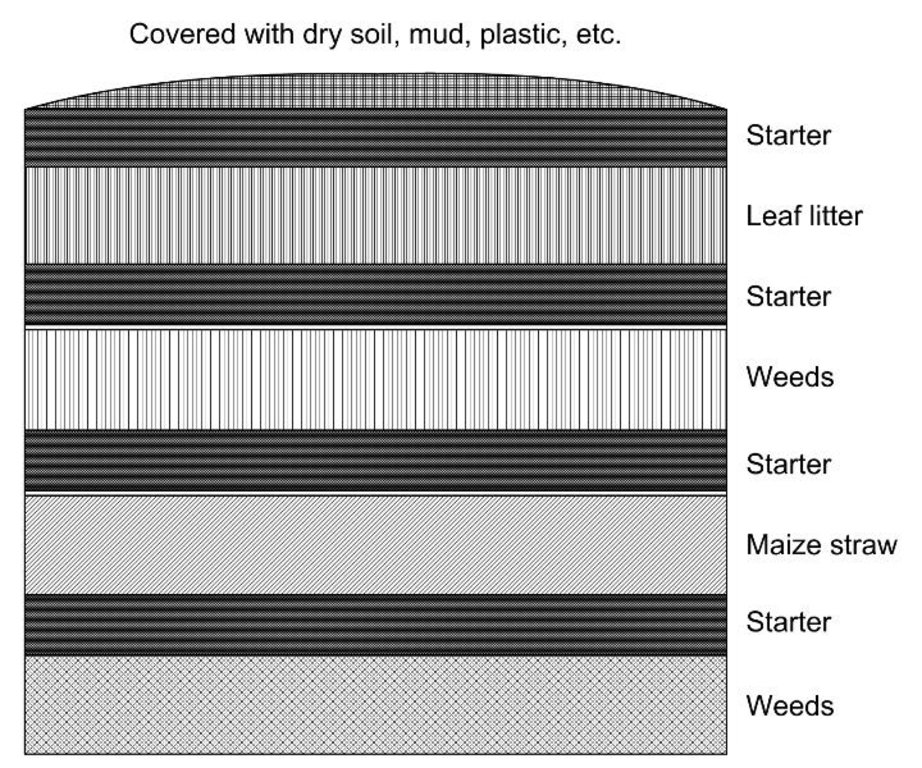Improved compost preparation [Népal]
- Création :
- Mise à jour :
- Compilateur : Richard Allen
- Rédacteur : –
- Examinateur : David Streiff
Sudhariyeko compostmal nirman (Nepali)
technologies_1750 - Népal
Voir les sections
Développer tout Réduire tout1. Informations générales
1.2 Coordonnées des personnes-ressources et des institutions impliquées dans l'évaluation et la documentation de la Technologie
Spécialiste GDT:
Director
+977 1 5520314
Soil Management Directorate, Department of Agriculture
Népal
Spécialiste GDT:
Team Leader
+977 1 5543591
ssmp@helvetas.org.np
Sustainable Soil Management Programme
GPO Box 688, Kathmandu/Nepal
Népal
Nom du projet qui a facilité la documentation/ l'évaluation de la Technologie (si pertinent)
Sustainable Soil Management Programme, Nepal (SSMP)Nom du ou des institutions qui ont facilité la documentation/ l'évaluation de la Technologie (si pertinent)
Department of Agriculture, Soil Management Directorate, Hariharbhawan Lalitpur (doasoil) - NépalNom du ou des institutions qui ont facilité la documentation/ l'évaluation de la Technologie (si pertinent)
HELVETAS (Swiss Intercooperation)1.3 Conditions relatives à l'utilisation par WOCAT des données documentées
Quand les données ont-elles été compilées (sur le terrain)?
06/11/2008
Le compilateur et la(les) personne(s) ressource(s) acceptent les conditions relatives à l'utilisation par WOCAT des données documentées:
Oui
1.5 Référence au(x) questionnaire(s) sur les Approches de GDT

Farmer field schools on integrated plant nutrient systems [Népal]
Participatory and collaborative learning through the farmer field school approach
- Compilateur : Richard Allen

Farmer-led experimentation [Népal]
Participatory technology testing and adaptation through farmer-led experiments
- Compilateur : Richard Allen

Farmer-to-farmer diffusion [Népal]
Wider diffusion of sustainable soil management technologies through a demand responsive farmer-to-farmer diffusion approach
- Compilateur : Richard Allen
2. Description de la Technologie de GDT
2.1 Courte description de la Technologie
Définition de la Technologie:
Improved compost preparation using a range of biomass and waste to produce high value fertiliser
2.2 Description détaillée de la Technologie
Description:
Compost can be prepared from a wide range of organic materials including dead plant material such as crop residues, weeds, forest litter, and kitchen waste. Compost making is an efficient way of converting all kinds of biomass into high value fertiliser that serves as a good alternative to farmyard manure, especially for crop-growing households without livestock. The compost is often mixed with forest soil, ripe
compost from the previous batch, or even a small amount of animal dung as a starter for the decomposition process. The mix of materials determines the quality of the final compost as much as the management of the composting process. Nitrogen-rich fresh materials such as legume residues and many types of weeds and shrubs are mixed with carbon-rich forest litter and cereal residues. Small amounts of wood ash, lime, or mineral fertiliser can help increase or balance the overall nutrient content of the compost.
The compost needs to be turned every 30-50 days depending on the mix and the outside temperature. It should be protected from direct sunlight, rainfall and runoff so as to reduce volatilisation and leaching of nutrients. The material must remain moist at all times to avoid slowing down decomposition and hindering the efficiency of the micro and macro-organisms involved in decomposition. Heaping the compost or collecting the material in a pit helps the compost to reach the temperatures needed (700C) to destroy pests and weeds.
Once the compost is well decomposed and has an earthy smell, it can be applied directly or stored for later application. It can be applied as a crop fertiliser in rows or to individual plants for improving general soil fertility and organic matter content, thus improving the soil structure and its water holding capacity.
2.3 Photos de la Technologie
2.5 Pays/ région/ lieux où la Technologie a été appliquée et qui sont couverts par cette évaluation
Pays:
Népal
Autres spécifications du lieu:
Midhills districts of Nepal
Map
×3. Classification de la Technologie de GDT
3.1 Principal(aux) objectif(s) de la Technologie
- Improve compost production
3.2 Type(s) actuel(s) d'utilisation des terres, là où la Technologie est appliquée

Terres cultivées
- Cultures annuelles
Commentaires:
Major land use problems (compiler’s opinion): Intensifying cultivation practices with either 1) the inadequate application of fertilisers leading to a decline in soil
fertility and the mining of soil nutrients or 2) the application of too much fertiliser causing environmental problems
through excessive leaching, and losses of fertiliser in surface runoff and consequent eutrophication or nitrification of
streams, ponds or groundwater.
3.4 Groupe de GDT auquel appartient la Technologie
- gestion intégrée de la fertilité des sols
- gestion des déchets/ gestion des eaux usées
3.6 Mesures de GDT constituant la Technologie

modes de gestion
- M7: Autres
3.7 Principaux types de dégradation des terres traités par la Technologie

dégradation chimique des sols
- Cn: baisse de la fertilité des sols et réduction du niveau de matière organique (non causée par l’érosion)
3.8 Prévention, réduction de la dégradation ou réhabilitation des terres dégradées
Spécifiez l'objectif de la Technologie au regard de la dégradation des terres:
- réduire la dégradation des terres
4. Spécifications techniques, activités, intrants et coûts de mise en œuvre
4.1 Dessin technique de la Technologie
4.2 Spécification/ explications techniques du dessin technique
Layering of the different materials in
a compost pit
Note: This is just an example and
need not be followed exactly. The
important aspects are:
- the need for a starter such as
forest soil or manure
- place weeds in the centre of
the pit so that they are fully
decomposed
- cover dry materials with moist
material and material that only
decays slowly with easily
decaying material.
The pit can be 1 to 2m in diameter
and about 1m deep.
The size depends on the available
biomass for composting and the
amount of compost required.
Technical knowledge required for field staff / advisors: low
Technical knowledge required for land users: low
Main technical functions: increase in soil fertility and productivity, increase in soil organic matter content, improvement in physicalsoil conditions, increase in soil water holding capacity
4.3 Informations générales sur le calcul des intrants et des coûts
Indiquez la monnaie utilisée pour le calcul des coûts:
- dollars US
Indiquez le coût salarial moyen de la main d'œuvre par jour:
2.00
4.4 Activités de mise en place/ d'établissement
| Activité | Type de mesures | Calendrier | |
|---|---|---|---|
| 1. | Dig a 1-2m diameter and 1m deep pit using a spade or shovel | Modes de gestion | |
| 2. | Collect crop residues, grass, tree leaves, ash, lime, and animal urine | Modes de gestion | |
| 3. | Put a layer of ash at the bottom of the pit followed by tree leaves, grass, crop residues, and a layer of forest soil (as it contains the necessary microorganisms – bacteria, fungi, etc. – and quickens the decomposition process) | Modes de gestion | |
| 4. | Add more tree leaves, crop residues, and grass until the pit is full and contains a healthy mixture of dry and fresh/moist materials | Modes de gestion | |
| 5. | Cover the compost heap with a fi ne layer of ash or mud and a cap of | Modes de gestion |
4.5 Coûts et intrants nécessaires à la mise en place
| Spécifiez les intrants | Unité | Quantité | Coûts par unité | Coût total par intrant | % des coût supporté par les exploitants des terres | |
|---|---|---|---|---|---|---|
| Main d'œuvre | Preparing compost pit | Persons/day | 2,0 | 2,0 | 4,0 | 100,0 |
| Coût total de mise en place de la Technologie | 4,0 | |||||
4.6 Activités d'entretien/ récurrentes
| Activité | Type de mesures | Calendrier/ fréquence | |
|---|---|---|---|
| 1. | Dispose of domestic and household wastewater and cattle urine in the pit to keep it moist (but not saturated/soaked) until it is fully decomposed. | Modes de gestion | |
| 2. | The compost needs to be turned every 30-50 days depending on the mix and the outside temperature. | Modes de gestion | |
| 3. | Depending on the location, it takes about 3-6 months for the compost to be fully decomposed. | Modes de gestion |
4.7 Coûts et intrants nécessaires aux activités d'entretien/ récurrentes (par an)
| Spécifiez les intrants | Unité | Quantité | Coûts par unité | Coût total par intrant | % des coût supporté par les exploitants des terres | |
|---|---|---|---|---|---|---|
| Main d'œuvre | Maintaining compost | Persons/day | 1,0 | 2,0 | 2,0 | 100,0 |
| Coût total d'entretien de la Technologie | 2,0 | |||||
Commentaires:
Cost as in January 2007
5. Environnement naturel et humain
5.1 Climat
Précipitations annuelles
- < 250 mm
- 251-500 mm
- 501-750 mm
- 751-1000 mm
- 1001-1500 mm
- 1501-2000 mm
- 2001-3000 mm
- 3001-4000 mm
- > 4000 mm
Spécifications/ commentaires sur les précipitations:
Annual rainfall: Also 2000-3000 mm
Zone agro-climatique
- humide
Thermal climate class: subtropics
5.2 Topographie
Pentes moyennes:
- plat (0-2 %)
- faible (3-5%)
- modéré (6-10%)
- onduleux (11-15%)
- vallonné (16-30%)
- raide (31-60%)
- très raide (>60%)
Reliefs:
- plateaux/ plaines
- crêtes
- flancs/ pentes de montagne
- flancs/ pentes de colline
- piémonts/ glacis (bas de pente)
- fonds de vallée/bas-fonds
Zones altitudinales:
- 0-100 m
- 101-500 m
- 501-1000 m
- 1001-1500 m
- 1501-2000 m
- 2001-2500 m
- 2501-3000 m
- 3001-4000 m
- > 4000 m
Commentaires et précisions supplémentaires sur la topographie:
Slopes on average: Also moderate (6-10%), rolling (11-15%) and hilly (16-30%)
Landforms: Also footslopes
Altitudinal zone: Also 1000-1500 m a.s.l., 1500-2000 m a.s.l. and 2000-2500 m a.s.l.
5.6 Caractéristiques des exploitants des terres appliquant la Technologie
Orientation du système de production:
- subsistance (auto-approvisionnement)
- commercial/ de marché
Individus ou groupes:
- individu/ ménage
Indiquez toute autre caractéristique pertinente des exploitants des terres:
Off-farm income specification: In most farm households, off-farm income plays at least a minor and increasingly a major role. Occasional opportunities for off-farm income present themselves in the form of daily labour wages. Some households’ members receive regular salaries, whilst an increasing number of Nepalis are working in India, the Middle East, Malaysia, and elsewhere and sending remittance incomes home.
5.7 Superficie moyenne des terres détenues ou louées par les exploitants appliquant la Technologie
- < 0,5 ha
- 0,5-1 ha
- 1-2 ha
- 2-5 ha
- 5-15 ha
- 15-50 ha
- 50-100 ha
- 100-500 ha
- 500-1 000 ha
- 1 000-10 000 ha
- > 10 000 ha
5.8 Propriété foncière, droits d’utilisation des terres et de l'eau
Propriété foncière:
- individu, sans titre de propriété
- individu, avec titre de propriété
Droits d’utilisation des terres:
- loué
- individuel
Commentaires:
Sharecropping between owner and tenant
6. Impacts et conclusions
6.1 Impacts sur site que la Technologie a montrés
Impacts socio-économiques
Revenus et coûts
dépenses pour les intrants agricoles
Commentaires/ spécifiez:
Reduced expenses on chemical fertilisers
charge de travail
Commentaires/ spécifiez:
Preparation of compost is labour intensive
Impacts écologiques
Autres impacts écologiques
Soil fertility
Organic crop production
Application of fertilizer
6.2 Impacts hors site que la Technologie a montrés
pollution des rivières/ nappes phréatiques
Commentaires/ spécifiez:
Reduction of nutrient influx into water bodies
Dependence on external inputs
6.4 Analyse coûts-bénéfices
Quels sont les bénéfices comparativement aux coûts de mise en place (du point de vue des exploitants des terres)?
Rentabilité à court terme:
positive
Rentabilité à long terme:
positive
Quels sont les bénéfices comparativement aux coûts d'entretien récurrents (du point de vue des exploitants des terres)?
Rentabilité à court terme:
positive
Rentabilité à long terme:
positive
Commentaires:
The high cost of mineral fertilisers means that the establishment costs are soon recovered. In the long-term, a major reduction in costs leads to large benefits.
6.5 Adoption de la Technologie
Commentaires:
Comments on spontaneous adoption: About 30% of the participants of SSMP activities related to compost making, and about 20% of farmers that were
not part of the programme have adopted the technology.
6.7 Points forts/ avantages/ possibilités de la Technologie
| Points forts/ avantages/ possibilités du point de vue du compilateur ou d'une autre personne ressource clé |
|---|
|
The use of compost reduced the need for mineral fertiliser thus reducing production costs and outside dependence How can they be sustained / enhanced? Further promote the technology to increase this impact |
|
Compost making does not require any livestock How can they be sustained / enhanced? Its low cost and use of local materials makes it the fertiliser of choice for poor households |
| In-situ composting saves labour involved in transporting compost to the fields |
6.8 Faiblesses/ inconvénients/ risques de la Technologie et moyens de les surmonter
| Faiblesses/ inconvénients/ risques du point de vue du compilateur ou d'une autre personne ressource clé | Comment peuvent-ils être surmontés? |
|---|---|
| The preparation of compost is not appropriate for commercial use (except in nurseries) | Compost improvement should go hand-in-hand with promoting alternatives for the other requirements |
| Compost requires a large amount of biomass which may otherwise be needed for fuel, fodder, or animal bedding |
7. Références et liens
7.2 Références des publications disponibles
Titre, auteur, année, ISBN:
STSS; SSMP (2001) Farmyard Manure and Compost Management (in Nepali). Kathmandu: Soil Testing Services Section, Department of Agriculture andSustainable Soil Management Programme
Disponible à partir d'où? Coût?
SSMP
Liens et modules
Développer tout Réduire toutLiens

Farmer field schools on integrated plant nutrient systems [Népal]
Participatory and collaborative learning through the farmer field school approach
- Compilateur : Richard Allen

Farmer-led experimentation [Népal]
Participatory technology testing and adaptation through farmer-led experiments
- Compilateur : Richard Allen

Farmer-to-farmer diffusion [Népal]
Wider diffusion of sustainable soil management technologies through a demand responsive farmer-to-farmer diffusion approach
- Compilateur : Richard Allen
Modules
Aucun module trouvé





